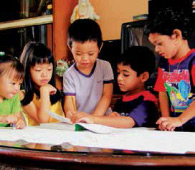Our blessed country is a brilliant melting pot culminating in a rich blend of cultures, traditions, and religions; it was founded on the basis of freedom and tolerance of differences in beliefs and cultures. Tolerance here simply refers to respecting and being open in accepting the differences that exist among different peoples. It is also about being conscious of the fact that no man is an island.
Children today are more exposed to people different from themselves and start noticing differences among people at a very early age. They learn certain attitudes and respond to those differences by seeing how adults (especially parents) react to them.
As parents, we may have biases and be hesitant in embracing diversity, yet it is still of extreme importance that we do not pass on our biases to our children as doing so means denying our next generation of the chance to reach their full potential.
Teaching tolerance to your child early is necessary, not just because being tolerant is the spine that holds us Malaysians, but because the child who learns to be open-minded to differences will tend to be given more opportunities in all aspects of life. In short, success in today’s world depends on being able to put all differences aside through mutual respect, understanding and being able to work and interact effectively with others.
Teaching tolerance is an integral part of a child’s personal development and success in the future. Despite the fact that they will eventually grow into their own person, their core values are instilled by you. By teaching your child to accept diversity of the world, you’ll be giving your child the gift of a lifetime.
Tips on how you can encourage tolerance in your child.
Talk about tolerance
Be willing to talk to your child about differences in people and try to establish open dialogues about all social issues. Make sure you handle your discussions in a non-judgemental manner as your child will pick up any prejudices or biases you may have.
Introduce diversity
Young kids will notice differences in other people’s looks — short, tall, thin, fat, skin colour, and gender differences. The reason being they are developing their individuality and curiosity about the world. What you can do is, observe and respond to their curiosity in simple terms.
Handle embarrassing moments
Children may comment loudly and embarrassingly on physical differences with no malice or prejudice intended. Handle situations like this by responding in a subtle manner. Keep your explanations simple, concrete, and positive. Explain that loud comments about someone’s appearance can hurt that person’s feeling.
Challenge prejudiced words
Let your child know from a very early age that name-calling and prejudiced remarks are hurtful and wrong. It’s important to discourage strong words like “I hate…” and not allow its usage against other people. Teach children to choose less extreme language, which will help them avoid negative generalisations later on.
Expose your children to different cultures and lifestyles
The more children are exposed to racial and cultural differences, the more comfortable they become with all types of people. It’s a gradual process that involves guiding them across cultural barriers. Try to create opportunities for your child to interact and make friends with people who are different from them. Involve other families in sharing their traditions, like food, games, and holidays.
Model the behaviour you would like to see
Parents are children’s primary role model. So, watch your own prejudices! Always be consistent in how you treat others and watch the language you use to describe others. Never use racist humour or other prejudiced remarks as children cannot always distinguish between a sarcastic remark and true feelings.
Teaching tolerance is an integral part of a child’s personal development and success in the future. Despite the fact that they will eventually grow into their own person, their core values are instilled by you. By teaching, to accept diversity of the world, you’ll be giving your child the gift of a lifetime.






Comments